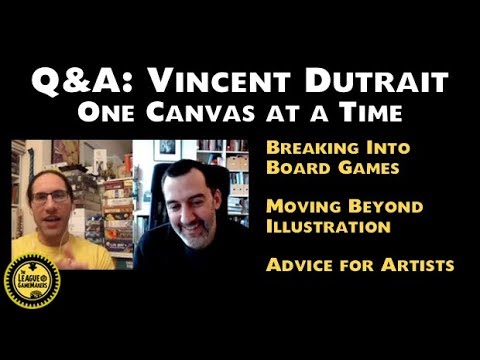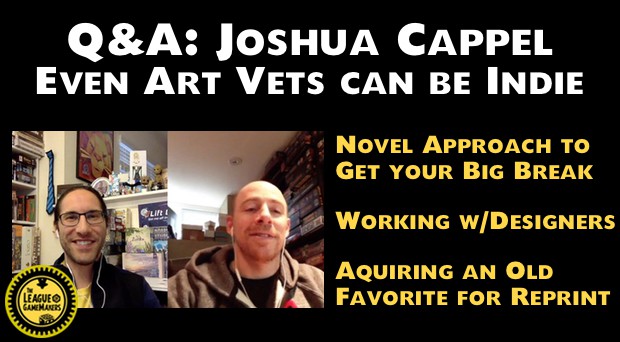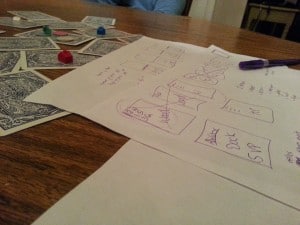
Part 1 of a 3 part series on the DFWNN Design competition – perspectives from two League of Gamemakers design teams!
—
Debate has been lively here at the League and in other realms of the game design kingdom over the starting gate for a game’s design. Luke Laurie proposed a mechanics first approach which was answered by Peter Vaughan’s argument for jumping in theme first. Mark Major tried to put it all in perspective, but there’s one design landmark that hasn’t been explored by the league to date. And that is the
CHALLENGE OF A COMPONENT DRIVEN DESIGN
I admit that up until this time, I have largely relied on theme to carry my design work. However, a simple design contest put on by some of my favorite people has thrust me into designing from components. The good folks at DFW Nerd Night are hosting their first game design contest. Over 70 entrants answered a short questionaire and 24 of them were selected to compete. Among those in this group of 24 are fellow League member, Jasmine Davis and me. She is co-designing with Pete Butler and I with League member and husband, Mike Domeny. The League is also getting in on sponsoring this contest, which includes Cosmic Wombat Games and Jeff’s podcast, Board Games and Brew. JR Honeycutt, founder of DFW Nerd Night, recently did an interview on said podcast, and you can listen to that here!
The following video is JR giving a description of the contest and components we are to use to create a board game.
So, to recap, the contest is to design a game that includes only (not necessarily all) of the following components:
A box, a fabric bag, 75 cards in three tuck boxes(25 each of three different weights), 5 colored cubes, 5 colored disks, 2 miniatures (may differ from the mouse and soldier in the video), one panda meeple, 2 D6, 2 dragon coins, 5 gems, 2 card stands, one brick, one square cardboard token, and one panda head shaped token, and one booklet from Panda GM.
It is my intent to chronicle my journey through a series of blog posts. Jasmine is vlogging her experience and those videos can be found by scrolling down. Many other designers are also blogging and vlogging their experience in this contest and those can be found on YouTube. The hashtag #DFWNN can be used to search for related topics on Twitter. But now, I get personal.
OUR APPROACH

As of this writing, We have not yet received our component box. But that’s fine, we’re not ready for it anyway. Once J.R. released the video to the contestants showing us what we would have to work with, Mike and I devised a plan. We brainstormed four or five ideas over the course of several days, allowing each to incubate a little.
We even scoured Luke’s piece “Steal this Game Idea” and the comments for inspiration. We thought through a panda adventure game using the panda meeple (it’s so cute!) We explored the idea of a maze game where the maze changes every round around the table. “A Day in the Death of Ted” was our top contender for a while, in which players would all be controlling one piece, “Ted,” and trying to kill him off by the end of a “day”. We mulled over these ideas and decided to take one to the white model stage. If that fails completely, we have three or four back-up ideas to try. That’s the plan.
THE PROBLEM OF INSPIRATION
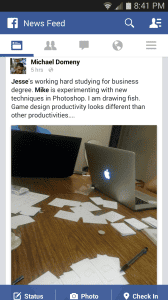
I have concluded that inspiration is hard to manufacture. Every other game we’ve designed had started with a spark of, “oooh, that’d be cool” and we made it a game. For this contest, we were not immediately inspired with any of the components. And since the contest required that these be the building blocks of our game, we were stuck for a while. It was several days and several ideas in before something made me yes, “Yes! That sounds fun!” Going with the mantra:
“FIND WHAT IS FUN IN YOUR GAME AND DEVELOP THAT”
– we knew when we had found our design. In our case, the piece of inspiration was Mike’s idea. He thought to create the “board” on which the game is played by randomly tossing cards on to the table, thereby creating a completely randomized and new board every game. Since I love making messes, I was very excited, and we got to work. At this point, the randomly thrown cards create the islands of Polynesia. The game is a civilization building game through resource gathering and management.
WHAT WE WANT
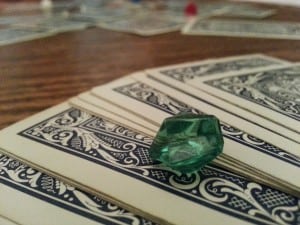
I was excited about this contest from the outset. We’ve been in a bit of a design dry spell, and a contest with a deadline felt like a great excuse to make ourselves design something. We also love and want to support DFW Nerd Night. But, beyond the joy of just making a game, we have specific things we want out of our game for this contest.
1. One tight, new mechanic.
As I said before, our designs have been heavily influenced by theme to the point that we have never designed “mechanics first.” We want to challenge ourselves to change that. The grand prize for this contest happens to be the opportunity to pitch the design to James Mathe of Minion Games. And, we know well enough that a publisher can change theme and flavor, it’s the mechanics they’re really buying. So, we want to design a game with one good tight mechanic that’s new. It may not be completely new to the world, but at least new to us, developed out of the place where our imagination meets the vast amount of already-made mechanics that inspire us every time we play a game.
2. Depth in spite of limited components.
We’ve been intrigued by micro games lately, and Mike has been working hard the past few months designing one. The game we’re designing for this contest isn’t micro, but we are including some of what we’ve learned from micro games. It is very important to us to make a game with great depth, despite limited components. This is really where theme is helping us dive in. We are working to create a world that our players can enter and be immersed in upon opening a box that’s only a few inches square.
One thing we’re doing to accomplish this big world in a little box is research. We’re doing more research for our theme on this game than any game prior. This research is flooding our theme with rich flavor and informing our mechanics! For example, in a resource gathering game, you always have to address the problem of one player hoarding the resources making it impossible for anyone to play. Our research told us that apparently tropical cyclones are a huge threat to the Polynesian people. Gardens can be poisoned by the salt from the storm surge and famine results. So, how do you keep players from hoarding? You send tropical storms to obliterate resources.
As of writing this article, we are two days in to designing this game. And, after overcoming the initial lack of inspiration, we’ve actually really enjoyed designing from specific components. The limitation has truly been good for our creativity. We’re looking at how to accomplish a mechanic, or how to utilize a theme, or how to create tension between players with much greater focus than before.
THE LIMITATION IS FORCING US TO BE CREATIVE, RESOURCEFUL, AND STREAMLINED IN OUR DESIGN.
And it’s so much fun!
—
JASMINE’S VLOG
I now turn you over to these inspiring Vlogs. From her experience in this component driven design challenge, here’s Jasmine Davis:
#1: In this video, Jasmine explains her feelings about the design competition and talks about why she’s doing it (and also explores the terror of getting married while also trying to design a game).
#2: What can you do when your box of components hasn’t arrived yet? Make amusing proxies using pieces from other board games and your design kit. Jasmine shows off what she’s using instead of the kit components, and talks a bit about what their current thoughts are with special guest Pete the Fiance.
#3: In this video, Jasmine explains what themes and game ideas she and Pete tried, and discusses why a 2-player co-op might not work. While they don’t yet have a finalized design, they’re working on a prototype of the “train dungeon crawler” idea and plan to test it out soon.
—
YOUR TURN
Have you ever designed a game based on a component list, or maybe a unique component was the initial spark of inspiration for your design? I’d love to hear your take on this design approach in the comments!

